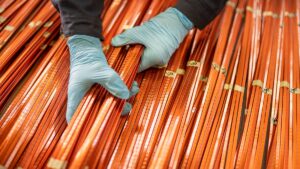Hungry for copper? These ASX developers are looking to fast track supply

Pic: Getty Images
- Despite the tumble in copper prices, some analysts believe Trump could mean good things for copper
- Supply challenges abound but a wave of new projects are looking to plug the gap
- ASX developers such as CLA, HGO and HCH are already making progress
Trump’s return to the White House triggered a dive in the copper price amid fears the global economy could be hit by a new tariff war, but it hasn’t dampened the demand for the versatile metal as the world shifts towards renewables and EVs.
Heavily exposed to China, prices of the red metal fell as much as 4.5% on the London Stock Exchange last Wednesday.
While the short-term turbulence spooked investors, several market analysts believe the Trump administration is likely to be pro-mining, which could mean more permitted projects and a quicker production timeline for assets in the US.
During his first term, Trump issued an executive order backing mining and critical minerals in September 2020 and reopened Minnesota’s Superior National Forest to mining in 2018 – a stark contrast to the 20-year mining moratorium placed on nearly 226,000 acres of land in the same area by the Biden administration.
Copper could also be a major beneficiary of the Trump administration if a bill that looks to bring copper onto the US Geological Survey (USGS) critical minerals list successfully passes through Congress.
According to the Copper Development Association, copper is at a disadvantage by not being eligible for the more extensive benefits targeted to the USGS critical minerals list, which would provide new tax and funding benefits to spur domestic demand.
Wave of new copper projects
Despite the world’s biggest miner BHP (ASX:BHP) tipping a 72% increase in global copper demand by 2050, the industry is facing a number of supply challenges including rising costs of capital for mining projects, depleting deposits and declining discovery rates.
S&P’s latest major copper discoveries report has highlighted a concerning trend in the industry, with only four discoveries recorded in the past five years as companies increasingly focus on extending known deposits rather than seeking new ones.
In the 1990s and early 2000s, 50% to 60% of copper exploration budgets were allocated to grassroots exploration, S&P said, while in 2023 that figure dropped to a record low of 28%.
The anticipated shortfall in copper supply has triggered a rush to bring mining projects online with a handful of ASX companies looking to plug supply.
Celsius Resources (ASX:CLA) is looking to produce 22,000t of copper and 27,000oz of gold in the first 10 years of production, starting from 2027, at the flagship Maalinao-Caigutan-Biyog (MCB) project in the Philippines.
The 2,500-hectare MCB mining tenement, some 320km north of the Philippine capital of Manila, is the subject of a mining permit issued in March this year which grants CLA’s affiliate company, Makilala Mining Company Inc, exclusive rights to carry out exploration, development and commercial production for 25 years, with a renewal option for another 25 years.
MCB was also the first project to be issued a Certification Precondition from the Philippines government in the past five years, which was the final milestone required for the asset to move forward and allows management to execute project funding arrangements.
CLA describes itself as a multi-asset copper-gold company with a timeline of projects that naturally progress one after another and a hefty 650Mt of JORC resources contained within just the first two projects – MCB and the Sagay Project in the Negros Island.
Production at Sagay, currently in the permitting phase, would begin a good 18 months to two years after MCB and has the potential to add significantly to its copper-gold production.
Early works to begin by year end
CLA executive director Mark van Kerkwijk (MvK) told Stockhead the company plans to start early works at the MCB project by the end of the year.
“The project will have a head grade of over 1.1% copper and over .5% g/t gold, with C1 costs for the first 10 years being well under $1/lb,” he said.
“The economics are outstanding with a very conservative model forecasting net income (including all taxes and royalties) of US$1.5 billion over the life of the mine.”
Van Kerkwijk said while it was the previous government that removed the moratorium, the current government under President Marcos is very supportive of mining and investors can be confident that the mining policy reforms ensure sustained support for the mining industry across administration lines.
“We are at the beginning of a new renaissance of sustainable mining in the Philippines,” he said.
“There are now clear permitting and approval structures and importantly a very structured native title system called FPIC which ensures that indigenous landholders participate in the benefits of new mining projects.
“Our fantastic in-country team has navigated all of the permitting and approval stages in record time and they have achieved this via building excellent community and government relationships.”
Copper production in SA
Hillgrove Resources (ASX:HGO) is one of very few ASX copper producers, following the restart of its Kanmantoo underground operation in South Australia.
Previously a producing open-pit mine, Kanmantoo produced 2923 tonnes of copper in 12,656 dmt of concentrate at an all-in cost of US$3.71 per pound of copper after by-product credits during the September quarter.
But there’s still plenty of scope for production growth at Kanmantoo with just 40% of the plant’s capacity being used.
An exploration target of 60-100Mt at 0.9-1.2% copper and 0.1-0.2g/t gold has been defined immediately around the processing facility with a significant part – 50-80Mt at 0.8-1.2% copper and 0.1-0.2g/t gold – of this concentrated within the Kanmantoo Deeps zone, which could be a repeat of the entire Kanmantoo copper-gold deposit just 400m from the decline.
A substantial increase to Kanmantoo’s ore reserve was made in October of 2.8Mt grading 0.91% copper and 0.15g/t gold containing 26,000t copper and 14,000oz gold while its mineral endowment grew to 19.3Mt grading 0.77% copper and 0.14g/t gold containing 150,000t copper and 82,000oz gold.
In an interview with Stockhead, HGO managing director Bob Fulker said Kanmantoo now has a potential mine life of between eight to 10 years.
“Before the increase in resources, we only had a short mine life of two years, so we have a lot to do in the next couple of years to stabilise and grow production,” he said.
“We’ve got a processing plant that will do 3.6 million tonnes and about five other pits that we haven’t drilled underneath yet so a lot of room for opportunity and growth.”
Copper in Chile
Hot Chili (ASX:HCH) is in the process of wrapping up a pre-feasibility study for its 2.8Mt Costa Fuego copper hub, due by the end of this year.
HCH has spent $220 million at Costa Fuego, completed a preliminary economic assessment for the project in 2023, outlining capital costs of US$1.05 billion.
Costs are low compared to the company’s copper peers due to Costa Fuego’s low elevation and proximity to the coast.
Costa Fuego is also one of a few projects outside the majors with the potential to produce around 100,000tpa copper.
The project is projected to produce 112,000t of copper equivalent in the first 14 years at a C1 cash cost of US$1.33 per pound, net of by-product credits.
Using a US$3.85/lb copper price and US$1750 an ounce gold price, the project has a post-tax net present value of US$1.1 billion and internal rate of return of 21%.
In March, the company entered an MOU with the existing Las Losas port facility in Chile to negotiate a binding port services agreement and in May $31.9m was raised by way of a $24.9m private placement and $7m share purchase plan to fund development and exploration activities over the next 18 months.
On the exploration front, HCH has kicked-off several programs at newly acquired concessions covering the Domeyko Cluster, which span an area of 141km2 and represents a 25% increase in the company’s total landholding at Costa Fuego.
At Stockhead we tell it like it is. While Hillgrove Resources and Hot Chili are Stockhead advertisers, they did not sponsor this article.
Related Topics

UNLOCK INSIGHTS
Discover the untold stories of emerging ASX stocks.
Daily news and expert analysis, it's free to subscribe.
By proceeding, you confirm you understand that we handle personal information in accordance with our Privacy Policy.








